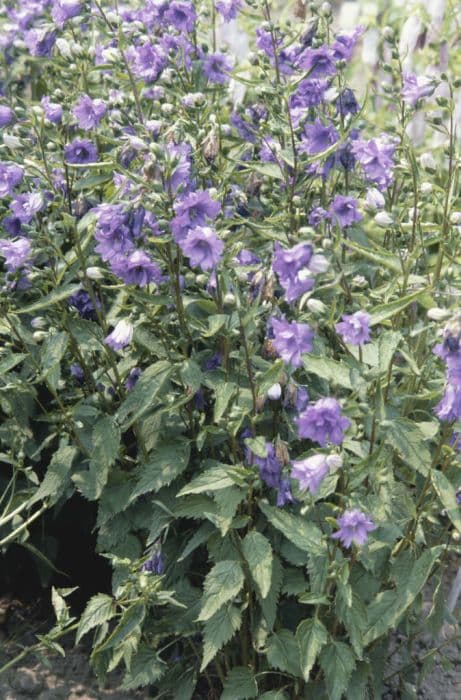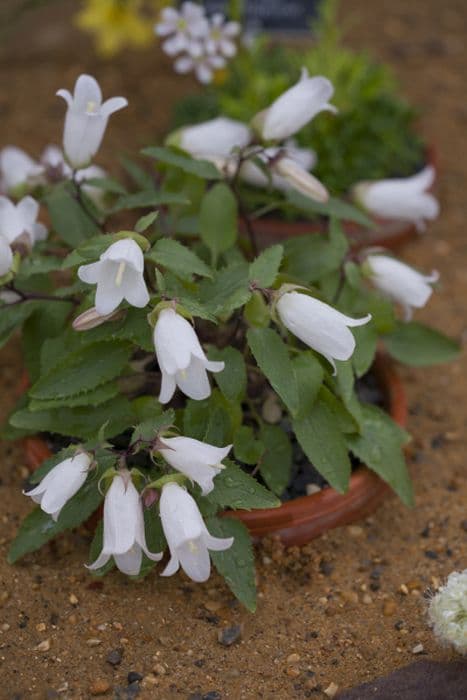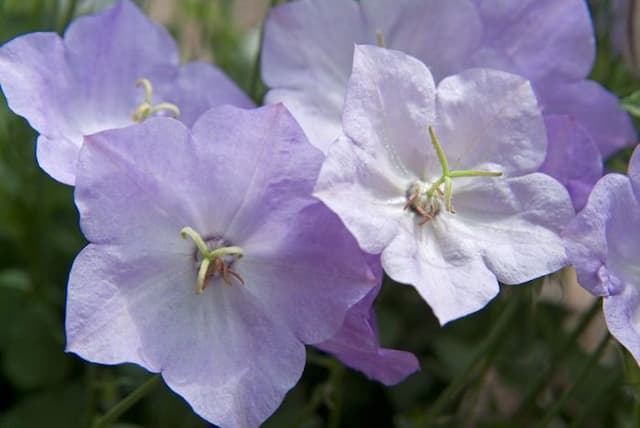Bellflower Campanula trachelium 'Bernice' (d)

ABOUT
Campanula trachelium 'Bernice', commonly known as bellflower, is a delightful clump-forming perennial that presents a lush display of deep green leaves. The foliage is characterized by its heart-shaped base and a slightly serrated margin, often with a rough texture. The leaves are arranged alternately along the robust stems, creating a backdrop for the prominent flowers. The bellflower's crowning glory is its blossoms, which emerge in clusters atop the sturdy stems. Resembling little bells or goblets, the flowers are richly doubled, giving them a full, almost ruffled appearance that adds to their charm. These blossoms usually come in a shade of violet-blue, which stands out against the verdant foliage, creating a pleasing contrast. The blooms are known for their tendency to attract various pollinators, such as bees and butterflies, adding to the life and vibrancy of any garden space where the bellflower takes root.
About this plant
 Names
NamesFamily
Campanulaceae.
Synonyms
Netted Bellflower, Throatwort, Bats-in-the-Belfry, Bellflower.
Common names
Campanula trachelium 'Bernice'
 Toxicity
ToxicityTo humans
The plant commonly known as Bellflower is not typically considered toxic to humans. There are no well-documented cases or significant reports of poisoning from Campanula trachelium 'Bernice'. It's always wise to be cautious and avoid ingesting parts of ornamental plants as a general safety measure, because individual sensitivities can vary, and some people may experience mild stomach upset or allergic reactions.
To pets
Bellflower is not specifically known to be toxic to pets like cats and dogs. There is no prevalent information indicating that Campanula trachelium 'Bernice' would cause poisoning in pets. However, as with humans, ingestion of non-food plants can potentially lead to mild gastrointestinal irritation or an allergic reaction in some animals. It is always recommended to prevent pets from consuming plants not intended for their diet.
 Characteristics
CharacteristicsLife cycle
Biennials
Foliage type
Deciduous
Color of leaves
Green
Flower color
Blue
Height
2-4 feet (60-120 cm)
Spread
1-2 feet (30-60 cm)
Plant type
Herb
Hardiness zones
5
Native area
Europe
Benefits
 General Benefits
General Benefits- Aesthetic Appeal: Adds a burst of color with its clusters of purple-blue flowers, enhancing the look of gardens and landscapes.
- Attracts Pollinators: Serves as a nectar source for bees, butterflies, and other beneficial pollinators, supporting biodiversity.
- Low Maintenance: Once established, requires minimal care, making it suitable for gardeners of all levels.
- Drought Resistance: Tolerates periods of dryness once mature, which can be especially useful in areas with water restrictions.
- Versatility: Suitable for a variety of garden settings, including borders, cottage gardens, and woodland settings.
- Perennial Growth: Comes back year after year, providing long-term presence and reducing the need for annual replanting.
 Medical Properties
Medical Properties- Anti-inflammatory: Campanula trachelium, commonly known as nettle-leaved bellflower, may possess anti-inflammatory properties that could be beneficial in reducing inflammation.
- Antiseptic: It has been suggested that the plant has antiseptic qualities, possibly useful in preventing or halting the growth of microbes.
- Soothing: The plant has been traditionally used for its soothing effects on sore throats and coughs.
 Air-purifying Qualities
Air-purifying QualitiesThis plant is not specifically known for air purifying qualities.
 Other Uses
Other Uses- Can be used in floral arrangements, especially for rustic or cottage-style weddings, where the bell-shaped flowers of the Canterbury Bells can add a touch of elegance and country charm.
- Canterbury Bells can also be used to create natural dyes for fabrics, with blue and purple petals yielding soft hues when used in the dyeing process.
- They are ideal for creating a fairy garden scene, as the large bell flowers can be made to look like colorful, natural homes or shelters for garden fairies.
- In photography, the vibrant colors and unique shape of Canterbury Bells make them a popular subject for macro and nature photography, inspiring a sense of wonder and attention to detail.
- The dried flowers of Canterbury Bells can be incorporated into homemade potpourris, providing a pleasant scent and adding visual appeal with their preserved form.
- This plant can be used for educational purposes in botany and horticulture programs, as an example of the Campanulaceae family and to teach about the care of perennial plants.
- The seed pods of Canterbury Bells can be collected and used in craft projects, such as making jewelry or as decorative elements in scrapbooking and paper crafts.
- As a hobby, enthusiasts may practice hybridizing Canterbury Bells with other Campanula species to create new, unique varieties with various colors and forms.
- The dried stems and flowers could be used in the construction of miniature thatched roofs for model making, providing a natural and authentic texture.
- They can act as companion plants in the garden, potentially deterring certain pests with their strong scent and robust growth habits.
Interesting Facts
 Feng Shui
Feng ShuiThe plant commonly known as Bellflower is not used in Feng Shui practice.
 Zodiac Sign Compitability
Zodiac Sign CompitabilityThe Bellflower is not used in astrology practice.
 Plant Symbolism
Plant Symbolism- Perseverance - The Campanula trachelium 'Bernice', commonly known as the Nettled Bellflower, often grows in tough conditions, symbolizing the ability to endure and persist.
- Gratitude - Like many bell-shaped flowers, the Nettled Bellflower is said to symbolize gratitude, thanks to its tendency to bow or nod, like a person giving a thankful gesture.
- Constancy - The bellflower is a symbol of unwavering faith and constancy, representing everlasting love and fidelity.
- Humility - The unassuming shape and posture of the Nettled Bellflower can represent humility, signaling modesty and a down-to-earth nature.
 Water
WaterThe Canterbury Bells should be watered deeply once a week, providing about 1 inch of water each time. During hot and dry periods, it may require additional water, possibly twice a week. Ensure the top inch of soil dries out between waterings to prevent overwatering. The water should be applied directly to the soil rather than overhead to minimize wetting the foliage, which could lead to fungal diseases. For potted Canterbury Bells, water until you see excess water flow from the drainage holes, indicating the soil has been thoroughly moistened.
 Light
LightCanterbury Bells thrive under full sun to partial shade conditions. They perform best if they receive at least 6 hours of direct sunlight, but they will also appreciate some afternoon shade in hotter climates. A spot that offers morning sunlight with protection from intense afternoon rays is ideal for these flowers to bloom well.
 Temperature
TemperatureCanterbury Bells prefer moderate temperatures and will grow best when daytime temperatures are between 60°F and 70°F. They can survive minimum temperatures down to about 50°F and maximum temperatures up to 80°F. Protecting the plants from extreme temperature changes, such as sudden frost or heatwaves, is beneficial to maintain their health.
 Pruning
PruningPruning Canterbury Bells is done primarily to remove spent flowers, which encourages additional blooming and prevents self-seeding if not desired. Prune them back after the first flush of flowers has faded, typically in mid-summer. A second, lighter bloom may occur if pruning is done promptly. The best pruning time is when the flowers begin to decline, which varies depending on the climate and growing conditions.
 Cleaning
CleaningAs needed
 Soil
SoilThe ideal soil mix for the Canterbury Bells 'Bernice' is well-drained, fertile loam with a pH between 6.0 and 7.5. Enrich the soil with compost and ensure it has good drainage to prevent waterlogging.
 Repotting
RepottingCanterbury Bells 'Bernice' typically does not require frequent repotting. Repot every 2-3 years or when it outgrows its current pot to provide fresh soil and encourage growth.
 Humidity & Misting
Humidity & MistingCanterbury Bells 'Bernice' prefer moderate humidity levels. They thrive in an environment that mimics their native habitat, so aim for humidity levels around 50-60%.
 Suitable locations
Suitable locationsIndoor
Place in bright, indirect light and keep soil moist.
Outdoor
Plant in partial shade to full sun and water regularly.
Hardiness zone
4-8 USDA
 Life cycle
Life cycleCampanula trachelium 'Bernice', commonly known as the bellflower 'Bernice', begins its life cycle when seeds are sown in the soil, where they germinate to produce small seedlings. The seedlings grow into juvenile plants with lush foliage and eventually mature, developing strong stems and leaves. The mature bellflower 'Bernice' then enters its flowering phase, typically in early summer, producing double, deep blue-purple flowers that attract pollinators. After pollination, these flowers develop into seed capsules, which when mature, split open to release seeds, thus completing the reproductive cycle. If environmental conditions are not suitable for seed germination, the plant can also propagate vegetatively through basal cuttings. As perennial plants, bellflower 'Bernice' may enter a period of dormancy during colder months, only to regrow from its rootstock with the arrival of favorable conditions in the following growing season.
 Propogation
PropogationPropogation time
Spring to Summer
Campanula trachelium 'Bernice', commonly known as the nettle-leaved bellflower, is often propagated by division, which is ideally done in the spring. To propagate by division, carefully dig up an established plant and gently tease apart the root ball into smaller sections, ensuring that each new section has a healthy amount of roots and at least one or two shoots. Replant the divisions at the same depth they were growing at previously, spacing them about 12 inches (approximately 30 centimeters) apart to allow room for growth. Water thoroughly after planting to help establish the new divisions. This method of propagation is straightforward and helps to maintain the vigor of the plant while providing new plants that are genetically identical to the parent.









